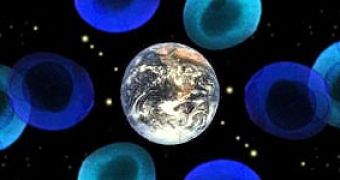Have you ever wondered what electricity the astronauts use?
It is the latest hardware: photovoltaics (solar panels), hydrogen fuel cells, radioisotope thermal generators. But Matthew Silver, a space systems engineer who heads IntAct Labs in Cambridge, Mass., advocates for microbes or proteins for new power supplies in space.
The biological power systems would be much simpler, cheaper, and flexible; they could come with a high power-to-weight ratio, convenient fuel storage and even useful byproducts like oxygen.
And the biological systems could be developed to suit the needs required in space. Two potential technologies would be microbial fuel cells, based on microbes that release electrons during metabolism, and gadgets that turn kinetic energy or radiation into electric current. The gadgets, dubbed "powerskin" by IntAct Labs, would look like a thin film made of proteins sensitive to movement or light. "The proteins responsible for hearing and eyesight have interesting electrical properties. In the inner ear, the protein prestin plays a key role in converting vibration into the electrical signals that are sent to the brain," said Silver.
They could "translate vibrations into charge" and "scavenge energy", from slight winds and vibration on planets to an astronaut's movement, to fuel sensors or various remote devices. "The idea is that it could power sensors that do not need wiring, so you would have the ability to generate electricity where you need it in applications that need not weigh very much. Because prestin converts a mechanical change into electricity, there is the possibility of being able to sense vibration with very high sensitivity," Silver describes the application on sensory devices.
Powerskin could also be based on light-sensitive proteins like rhodopsins, encountered in cyanobacteria and similar to light-sensitive molecules of the retina.
Genetically engineered microbes, like yeast, can synthesize rhodopsins.
The microbial fuel cells would use anaerobic bacteria to digest organic matter and produce electricity. The most viable could be Geobacter, an anaerobic type that oxidizes organic matter, releasing electrons for the iron oxide particles in the surroundings (soil or muck).
A graphite electrode could replace the iron oxide as the electron acceptor. An advantage would be that the fuel doesn't have to be clean, so waste products can be employed.
A microbial fuel cell could digest human waste and other organic garbage during a space journey. A crew of six would produce 10.55 kilograms of waste daily en route to Mars. "That quantity of waste could produce up to about 1 kilowatt of constant power in a microbial fuel cell", Silver calculated. That's exactly what life support systems on such a craft would require.
The carbon dioxide resulted from the bacterial oxidization of organic waste could be employed to grow algae in sunlit space, resulting oxygen, while the organic matter synthesized by the algae would re-fuel the microbial fuel cell.
Another advantage of microbial fuel cells for space journeys is that organic matter is easy to store. Electricity generated from a photovoltaic panel must be stored in big batteries, while the bacterial power cell can be stored in minimal amounts, just as needed to generate electricity. Silver says that "If you design it right, you could imagine having the ability to fabricate your technology on the lunar or Martian surface. Imagine looking at power systems not as something that is extremely valuable, but as something that can be grown as needed."

 14 DAY TRIAL //
14 DAY TRIAL //